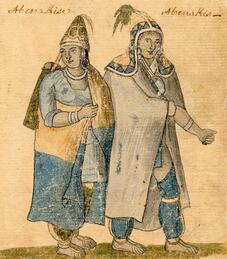|
The contents of this article are summarized from a Cowasuck.org webpost that is no longer active. Some changes have been made to simplify or clarify language for young readers. Additional information regarding the role of women was added with the source listed below.  Wikimedia Commons Wikimedia Commons The division of jobs was based on a philosophy of life, a religious belief. In general, the men hunted for wild game and gathered fish. The women worked in the fields. It is often assumed by many commentators that the life of the Native man was one of leisure, with the bulk of the heavy work done by the woman. The man was responsible for hunting, trapping, fishing, clearing trees, building the wigwam or long house, making the canoe, carving the household cooking and eating items, and instructing the young boys. Perhaps most importantly, he was also responsible for ensuring the safety of his family, clan, and band. The women gathered water and wood. They prepared and cooked meals, picked all types of berries and nuts. They gathered lily roots, wild rice, onions, chives, wild garlic, mushrooms, mint, swamp cabbage among many of the wild plants. They gathered herbs for medicines and garnishes. Additionally, women cared for, raised, and educated the children. They tended to births and deaths. They prepared hides, made clothes and snowshoes, set up and tore down shelters, and after engaging in all these physical tasks, women were also the primary decision makers. Women were involved in all major decisions involving their community. [Girouard, 2017] The women also planted the "three sisters" crops. On a big mound, they planted corn that grew upwards and provided natural poles for beans. Then squash or pumpkins were planted at the base where they spread all around the mound providing a cover to keep in the moisture and prevent weeds. All three were harvested at the same time. They were also dried to be used during the winter. There could be no sustenance farming of the "three sisters" if there existed danger of enemy raids against the villages. Therefore, defense was an important aspect. In the historic period, it became necessary to erect perimeters of palisades around the village. Men were responsible for cutting down long trees, most likely pine, which were then sharpened on both ends and embedded several feet into the earth around the main village dwellings. Look-out towers stood high above, so that there would be a chance of early warning should danger threaten. To be a warrior meant that one had to endure without complaint cold, hunger, pain, and weariness. This was what the young boys aspired to, and with the help of their maternal uncles, they were trained from an early age to shoot the longbow and wield the tomahawk and knife. They learned to walk swiftly and silently through the forest, tracking animals or people with deadly skill. Girouard, M. (2017, March 15). Wabanaki women - blog for Women’s History Month. Wabanaki REACH. https://www.wabanakireach.org/wabanaki_women_blog_for_women_s_history_month  Wikimedia Commons Wikimedia Commons During the American Revolution, Germany was made up of more than 300 small regions. These regions supplied soldiers to the British to fight against America. The largest group came from Hesse-Cassel. Because of this, all the German soldiers fighting with the British were called Hessians. King George III of Britain paid for the services of the Hessians because he didn't have enough soldiers for his army in America. The German soldiers, although often thought of as mercenaries, didn't get much in return for their service. Most of them only received basic necessities. The Prince of Hesse-Cassel, Frederick II, made a good deal by selling the services of 12,000 Hessians to the English. In total, around 30,000 German soldiers fought for the British in North America. When they arrived, they found a large German-American community of almost 200,000 people. Many Hessians were tempted to desert the British and stay in this new land with its growing German population, so about 5,000 Germans chose to remain in America, while the rest went back home. |
Author
I often struggle to find websites with thorough explanations in simple language to help kids understand historical events or scientific concepts, so I decided to create some of my own! -Cookie Davis
Archives
March 2024
|



 RSS Feed
RSS Feed